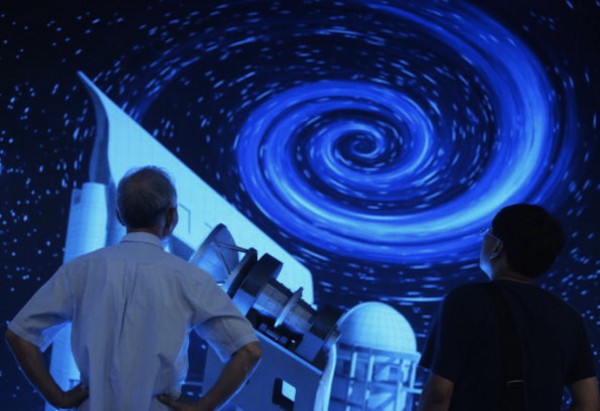Chinese Astronomers Release Data Trove; Find Black Hole Size of Beijing
| Michael A. Katz | | Jan 04, 2016 02:58 PM EST |
(Photo : Getty Images) Visitors view a model of the large sky area multi-object fiber spectroscopic telescope (LAMOST) in Shenzhen, China. The telescope has recently sent back a trove of data.
Chinese astronomers, using one of the world's largest optical telescopes, have released a trove of data.
Using the Large Sky Area Multi-Object Fiber Spectroscopic Telescope, or LAMOST, astronomers have been carrying out an extensive survey of the sky since September 2012. And according to the National Astronomical Observatory (NAO) of China, the survey has so far collected more data than all previous sky surveys combined.
Like Us on Facebook
"As more and more data are released, there will be more significant findings," Yan Jun, director of the NAO, told Chinese state media.
The astronomers plan to collect more than 5 million star spectra by September for the first phase of the survey. The data will then be used to create a so-called "digital galaxy" for research on the Milky Way, will be shared with 31 colleges and institutes in China and abroad.
Additionally, a team of scientists from China, the U.S., Canada and South Africa, among other countries, conducted 700 hours of surveys using the Green Bank Telescope and accumulated a large database. When they started to analyze the data, they found the radio bursts and reported the discovery to the science journal Nature last month.
In other astronomy news, researchers with the NAO have been collaborating with U.S. scientists to measure a black hole named X-ray Nova Muscae 1991 in the Milky Way.
They have found that the size of the black hole is comparable to the size of the Chinese capital Beijing, which is nearly 6,500 sq miles. The black hole stretches 60 kilometers across, and has a weight approximately 11 times that of the sun, and travels at a speed of about 387 rotations per second.
Although scientists have identified 19 black holes in the Milky Way, they have only been able to measure only six of them.
TagsChinese Astronomers Release Data Trove Find Black Hole Size of Beijing, Large Sky Area Multi-Object Fiber Spectroscopic Telescope, LAMOST, National Astronomical Observatory, NAO
©2015 Chinatopix All rights reserved. Do not reproduce without permission
EDITOR'S PICKS
-

Did the Trump administration just announce plans for a trade war with ‘hostile’ China and Russia?
-

US Senate passes Taiwan travel bill slammed by China
-

As Yan Sihong’s family grieves, here are other Chinese students who went missing abroad. Some have never been found
-

Beijing blasts Western critics who ‘smear China’ with the term sharp power
-

China Envoy Seeks to Defuse Tensions With U.S. as a Trade War Brews
-

Singapore's Deputy PM Provides Bitcoin Vote of Confidence Amid China's Blanket Bans
-

China warns investors over risks in overseas virtual currency trading
-

Chinese government most trustworthy: survey
-

Kashima Antlers On Course For Back-To-Back Titles
MOST POPULAR
LATEST NEWS
Zhou Yongkang: China's Former Security Chief Sentenced to Life in Prison

China's former Chief of the Ministry of Public Security, Zhou Yongkang, has been given a life sentence after he was found guilty of abusing his office, bribery and deliberately ... Full Article
TRENDING STORY

China Pork Prices Expected to Stabilize As The Supplies Recover

Elephone P9000 Smartphone is now on Sale on Amazon India

There's a Big Chance Cliffhangers Won't Still Be Resolved When Grey's Anatomy Season 13 Returns

Supreme Court Ruled on Samsung vs Apple Dispute for Patent Infringement

Microsoft Surface Pro 5 Rumors and Release Date: What is the Latest?













